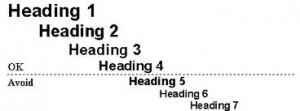Subheads for Clarity, If not Beauty
Posted on August 30, 2013
Filed Under Communication, Technology, The Writing Life | Leave a Comment
Technical writing needs to be orderly, but to insure that it’s read and understood by busy people, it definitely shouldn’t be dense. Aside from writing reasonably short, orderly sentences, adding subheads when the focus changes a bit is a mechanical, but very helpful, way of keeping a reader with you. Subheads are perhaps a tech writer’s most valuable organizational tool.
 Tom Johnson, on his excellent “I’d Rather Be Writing” technical writing blog, deals with the virtues of subheads at some depth. Tom took a poll on why “users can’t find answers in help material.” And he found that “help is either too long so users can’t find the answer, or help is too short so users can’t find the answer.” So what’s needed is a mechanism to facilitate organizing and scanning a page. (Oh, there’s that “f” word again.) Subheads are the answer both to orderly writing and orderly page layout.
Tom Johnson, on his excellent “I’d Rather Be Writing” technical writing blog, deals with the virtues of subheads at some depth. Tom took a poll on why “users can’t find answers in help material.” And he found that “help is either too long so users can’t find the answer, or help is too short so users can’t find the answer.” So what’s needed is a mechanism to facilitate organizing and scanning a page. (Oh, there’s that “f” word again.) Subheads are the answer both to orderly writing and orderly page layout.
Use subheads, first, to organize material that belongs together and then to draw your reader’s eyes to your handiwork. You’ve made his or her day when it’s easy to follow what you’re presenting. Subheads along with reasonably clear writing are the answer. They’re both attractive typographically and highly utilitarian. (Below a subhead, or instead of one, a “bullet” dot to set off key sentences or paragraphs can also be helpful.)
A maximum of four indented subheads on a page, as illustrated here, may actually be too many, unless your material is so complex that it requires them. Definitely avoid run-on subheads, as much as run-on writing. The idea is to be organized, not typographically lush. Typographical techniques aren’t a substitute for clear, well-organized writing, just helpmates in negotiating your terrain. The eye can be distracted by too many of them.
“Almost any Wikipedia page provides a great example of subheadings in action,” Tom notes. “There we have many paragraphs of content broken up by subheadings, with a built-in navigation embedded at the top. It’s a model that seems to work well on the web.” Subheads work well on paper, too, if they’re not overdone. Keep them always in mind as your technical writing unfolds. – Doug Bedell
Comments
Leave a Comment
If you would like to make a comment, please fill out the form below.
Recently
- Presentations With Forethought
- Technical Writing’s Lineage – Surely It’s Deeper than Digital
- At the Holidays, Twitting Amazon
- Successful Cookie Baking – From Mom, an Acknowledged Expert
- Slides for a Tech Writer’s Craft
- Digital or Not, Be Clear
- Being Watchful About Digital Designs…
- When Proposals Don’t Click, Keep Making Them Anyway
- Like a Good Gardener, Help an Enterprise Keep Itself Current
- We’re Leaders All, And Need to Think That Way
Categories
Archives
- January 2017
- December 2016
- November 2016
- October 2016
- September 2016
- August 2016
- July 2016
- June 2016
- May 2016
- April 2016
- March 2016
- February 2016
- January 2016
- December 2015
- November 2015
- October 2015
- September 2015
- August 2015
- July 2015
- June 2015
- May 2015
- April 2015
- March 2015
- February 2015
- January 2015
- December 2014
- November 2014
- October 2014
- March 2014
- February 2014
- January 2014
- December 2013
- November 2013
- October 2013
- September 2013
- August 2013
- July 2013
- June 2013
- May 2013
- April 2013
- March 2013
- February 2013
- January 2013
- December 2012
- November 2012
- October 2012
- September 2012
- August 2012
- July 2012
- June 2012
- May 2012
- April 2012
- March 2012
- February 2012
- January 2012
- December 2011
- November 2011
- October 2011
- September 2011
- August 2011
- July 2011
- June 2011
- May 2011
- April 2011
- March 2011
- February 2011
- January 2011
- December 2010
- November 2010
- October 2010
- September 2010
- August 2010
- July 2010
- June 2010
- May 2010
- April 2010
- March 2010
- February 2010
- January 2010
Blogroll